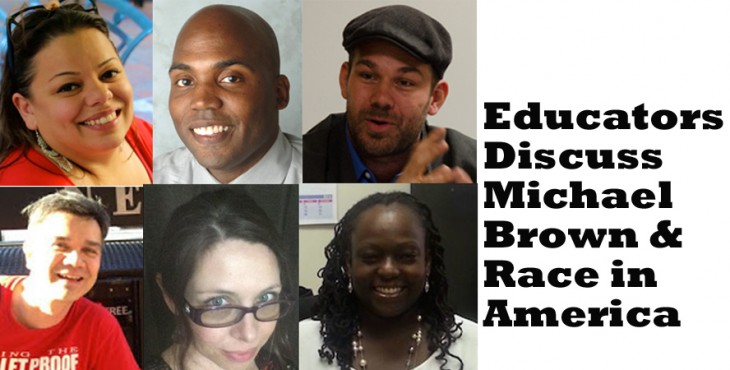by Yohuru Williams.
1. In terms of a response to the Michael Brown shooting, what is our responsibility as educators and citizens who care about social justice?
One of the most important things to remember is that the Michael Brown shooting, like any teachable moment, is an opportunity for educators to help students to think about and apply their academic studies to real issues. The Brown shooting, for example, is a good example of rights and responsibilities in a participatory democracy. In the immediate aftermath of the shooting the community called for transparency and the release of the name of the officer involved. The police did not comply. And once they did, they introduced information, the surveillance store video, which cast Michael Brown in a negative light. This is tailor made for a civics or government class. It is not only Civics teachers and Social studies teachers, however, who can thoughtfully engage students in these issues, however. The Michael Brown shooting provides opportunities for classes and schools to come together as a learning community and discuss collectively what this moment means and how they all might work collectively toward preventing such a tragedy from happening again.
That’s a much larger conversation that brings diverse voices to the table and allows people to share views in a forum where everyone can be speak and be heard .
2. What are some productive ways to initiate and engage in dialogue with others on issues of racism?
Debates about racism can be thorny—because of the reluctance of people to offend. It is always a good idea to initiate dialogue that allows students to appreciate the larger issues beyond their personal views and experience. Many white students for instance, are quick to dismiss the impact of racism and express frustration at welfare and affirmative action programs that they see as minority entitlement programs. Others express anger over the necessity of Black History Month and complain that they hear too much about Civil Rights and racism. Navigating these feelings can be tough, if the lesson or discussion is not grounded in the facts and history of racial oppression in the United States and beyond. I have always found it easier to use contemporary moments to broach these issues. The murder of Trayvon Martin, for example provided the opportunity to engage students on the history of residential segregation and racial apartheid in the United States and how African Americans have routinely been denied access to certain spaces. Being able to provide a contemporary connection allows students to see the issues less in the abstract and appreciate the deeper dimensions of why this study is important. The key word here is also productive. Educators should be very clear what their goals and objectives are in cases like this. One of the worst things that can happen is to initiate a dialogue that ends abruptly without any resolution. I don’t mean that students have solved the problem—but that they have no way to channel the unresolved issues the dialogue raises. For me such conversations should always be tied to a written reflection piece that follows the conversation that directly asks students to consider what they might work toward solutions beyond the discussion. This should be followed up with an opportunity for students to share with one another and perhaps even a group project that symbolizes action. A trip to a soup kitchen, an effort to clean up a neighborhood park, a community talent show to raise awareness—something that says this issue matters to us and we want to help. It is really about giving students a sense of agency—the feeling that they have the power to change things by taking concrete action born of study, dialogue, and reflection,
Yohuru Williams is Professor of History and Associate Vice President for Academic Affairs at Fairfield University and a former high school history teacher.





Leave a Reply